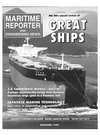
Page 36: of Maritime Reporter Magazine (December 1996)
Read this page in Pdf, Flash or Html5 edition of December 1996 Maritime Reporter Magazine
Shipbuilder: ... .Shipyard Trogir
Vessel Name: Trogir
Ship Type: Double Hull Oil Tanker
Owner/Operator: Trogir
Shipping Ltd.
Trogir is the first in a series of 12 double hull, 39,990-dwt oil tankers designed and contracted by ship- yard Trogir and built for sub- sidiaries of Novorossiysk Shipping
Company of Novorossiysk during 1995 and 1996 by Shipyard Trogir.
Part of the series was built by
Croatian yards Split, Uljanik and 3.Maj. Shipyard Trogir has been working for the last 10 years on the double hull designs of this ship size. Originally, the design was based on a full breadth cargo tank concept. However, this was fore- gone in the favor of a longitudinal centerline bulkhead concept, as the latter was found to be advanta- geous in terms of steel savings and unlimited loading/unloading se- quence, regardless of the number of partly filled cargo or ballast tanks. The cargo tank area is divided into 10 cargo tanks, two slop tanks and 10 ballast tanks with smooth inner hull arranged to
IMO and OPA 90 requirements.
The cargo system is designed to handle five segregations simulta- (Continued on page 69)
Shipbuilder: .. .Samsung Vessel
Name: EagleBoston
Vessel Type: . .Crude Oil Tanker
Owner/Operator: NOL
Eagle Boston is the first of four 99,300-dwt shallow draft, crude oil tankers for Neptune Orient
Lines Ltd. (NOL) of Singapore, from Samsung Heavy Industries
Co., Ltd. The vessel and its sis- terships are designed to carry crude oil to shallow water ports such as Linden, N.J., where the maximum draft is 11.15 m.
Compared to similar vessels of this class, the characteristics of the hull form are an unusually shallow draft and wide beam with the high ratio of 3.96 (breadth/draft). Offering a shal- low draft in a full form ship with wide beam presents several tech- nical problems, including maneu- vering performance and propul- sive performance. In order to
Eagle Boston Main Particulars
Classification: DNV, +lal, "Tanker For Oil", Eo
Length o.a.: 253 m
Length b.p.: 242 m
Breadth, Molded: 44.2 m
Depth, Molded To Moin Deck: 19.2 m
Gross Tonnage: 57,456 tons
Deadweight (Scantling): 99,300 M.T.
Draft (Design): 11.15 m
Speed, Service: 14.35 knots
Main Engine: Samsung B&W 6S60MC
Propellers: Single 4 Blade FPP
Engine Control(S): Integrated Automation
System, One Engine Control Room
VHF, SSB Radios, Radar: JRC
Compass: Tokimec
GPS: JRC meet IMO guidelines for maneu- verability, Samsung focused its attention on the maneuvering performances without sacrificing speed performance during the hull form design stage.
Extensive tanks tests were conducted with alternative hull forms. The final hull form select- ed has proven to offer great maneuverability in both mock-up tests and at sea trials. Three dif- ferent grades of cargo can be han- dled simultaneously, using three steam turbine driven cargo oil pumps of 2,500 cu. m./h each.
The main engine is a Samsung- built MAN B&W 6S60MC which develops 16,680 bhp at 105 rpm.
The engine drives a FPP, allowing the vessel to achieve a service speed of 14.4 knots. The inte- grated control and alarm moni- toring system (ICMS) is designed to be operated from the wheel- house.
Shipbuilder: Daewoo Heavy Industries
Ship Name: Astro Sirius
Ship Type: Aframax Tanker
Owner/Operator: ... .Kristen Navigation Inc.
Astro Sirius — an Aframax tanker built for
Kristen Navigation, Inc. — is one of two vessels built by Daewoo Heavy Industries to be hon- ored as a Great Ship this year. Designed by
Daewoo for a Greek owner, the Astro Sirius is the third in a five-ship order for Kristen. The ship is one of a series which uses a new struc- tural design philosophy aimed at producing stronger, safer ships, which comply with all of the latest international safety and environmen- tal regulations.
The 248-m, 53,074-gt ship is powered to a ser- vice speed of 15.2 knots by a Hyundai B&W 5S70MC engine, which delivers 19,100 bhp at 91 rpm. Four-blade, 8,000-mm diameter pro- pellers are driven via a 610-mm diameter shaft.
Engine controls are from Norcontrol, and fuel consumption is 52.18 ton/day.
Structurally, the Guide for Dynamic Based
Design and Evaluation of Tanker Structures of the ABS classification have been applied. About 60 percent of the con- struction is high-tensile grade steel.
To ensure long-term stability, a hull stress monitoring system from BMT is installed. This system incorpo- rates four deck strain gauges and a bow accelerometer for checking actu- al bending movement and bow motion.
Electronics onboard include an array of equipment from JRC (VHF and SSB radios, radar, GPS and
Satcom-C); and a Tokimec autopilot.
Two-stripe coating with pure epoxy has been applied to cargo and slop tanks (and to the outfittings in the tanks) allowing the vessel to carry crude oil and oil products, and to mini- mize free edges and to eliminate blind spots.
Inexa bulb plates are used in ballast tanks of the cargo areas to improve the quality of the protective coatings.
Astro Sirius has a cargo space divided into six tanks by transverse bulkheads and slop tanks aft, with one longitudinal bulkhead forming 38 Maritime Reporter/Engineering News

 35
35

 37
37
